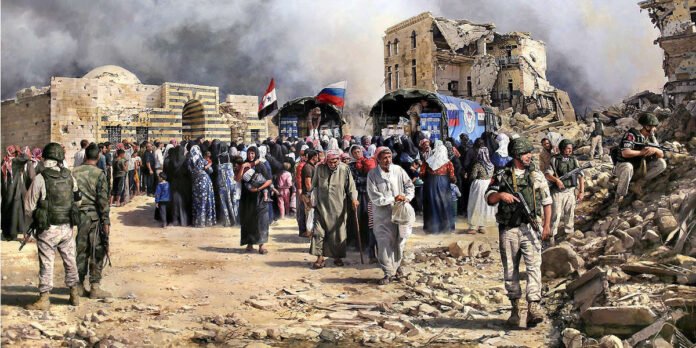The world is increasingly being engulfed by political turmoil, and externally motivated regime change leading to instability and the rise of fundamentalist forces. This has led to a power vacuum being exploited by Islamist forces along with other faultlines of socio-economic grievances, and weak governance, threatening regional stability.
Islamic fundamentalism from a socio-cultural movement has evolved into a socio-political movement to replace existing state systems with an Islamic governance model using violent and toxic ideology to achieve its goals. These draconian shadows of Islamist terrorism and radical extremism have already engulfed the world and its societies at an unprecedented pace.
HTS in Syria and ISIS affiliates in Iraq and Yemen in the Middle East. ISIS and Al-Qaeda in Libya, Algeria, and Sudan in North Africa. Al-Shabaab in Somalia, Boko Haram in Nigeria, and insurgencies across the Sahel and Mozambique engulf the region. South Asia grapples with Taliban-backed factions in Afghanistan, the TTP in Pakistan, Rohingya in Myanmar and JMB in Bangladesh. Even, Indonesia and the Philippines in Southeast Asia face these threats.
India’s rise in an interconnected world surrounded by a coup-prone Islamist state of Pakistan, Bangladesh as a new frontier and internal faultlines makes the situation perilous as it grapples with the spectre of Islamic radicalism. Addressing these threats requires integrated military, political, and socio-economic efforts to stabilise fragile states and curb extremist ideologies.
Islamist Rise and Attendant Turmoil
The emergence of Afghanistan as a stimulus for extremism, Syria’s radicalisation surge, and Bangladesh giving space to Islamist forces is the rollover of the past into the present.
Afghanistan: The Taliban’s takeover of Kabul on August 15, 2021, marked a symbolic victory for jihadist movements over superpowers like Russia and the US, emboldening extremist groups worldwide. Afghanistan has become a catalyst for Islamist forces like the Islamic State-Khorasan Province (ISKP), aggravating regional instability through violence, intolerance, and ideological hoods.
India’s rise in an interconnected world surrounded by a coup-prone Islamist state of Pakistan, Bangladesh as a new frontier, and internal faultlines make the situation perilous as it grapples with the spectre of Islamic radicalism in the country
Syria: The fall of Assad’s regime to HTS has catalysed Islamist forces in Syria, becoming a new rallying point for jihadist ideologies, reminiscent of ISIS’s rise, intensifying regional and global instability.
Bangladesh: The overthrow of Sheikh Hasina’s government and the rise of Islamist factions signal a rise of another Pakistan albeit Terroristan. Jamaat-e-Islami and Hifazat-e-Islam, exploiting the political vacuum, pose serious threats to regional stability to the region, particularly for India.
Ripple Effects of the Past: Iraq, Sudan, and Libya
Each of these nations demonstrates the complexities of Islamist rule, the challenges of foreign interventions, and the broader implications for regional and global security.
Iraq: U.S. fake rationale intervention led to sectarian divides, creating fertile ground for ISIS. Post-ISIS, Iraq struggles with rebuilding and ongoing insurgent threats.
Sudan: Post the Sudanese civil war, the risk of Sudan re-emerging as a hub for jihadist terrorism in Africa is on the rise. With the emergence of Islamist-leaning militias locally, Sudanese ‘diaspora’ foreign fighters involved in jihadist groups abroad and with a broader interest in IS may use Sudan as a hub for Islamist forces.

Libya: NATO’s intervention collapsed Gaddafi’s regime, leading to Islamist dominance, with Libya remaining a fragmented state. ISIS-Libya (ISIS-L) is one of several terrorist groups that emerged in the aftermath of Libya’s two civil wars, seeking to establish an anti-Western Islamic caliphate in Libya. The group has conducted terrorist attacks, kidnappings, and executions against a wide range of targets in North Africa.
The Broader Implications
The victories of Islamist regimes in Afghanistan, Syria, and Bangladesh have far-reaching implications:
Global Inspiration for Extremist Groups: The triumph of Islamist forces over moderate regimes serves as a morale booster for jihadist organisations worldwide, providing them with examples of successful insurgencies against secular or foreign-backed regimes. This could lead to increased recruitment and funding for groups such as ISIS, Al Qaeda, and their affiliates.
Regional Instability: Neighbouring countries face heightened risks of spillover effects, including refugee crises, cross-border terrorism, and the proliferation of radical ideologies. India remains vulnerable to this Islamic crescent and its rise in the neighbourhood. The internal turbulence and waves are already becoming tides if not curbed.
Polarisation and Radicalisation in New Frontiers: The ripple effects extend beyond traditional hotspots. Radical Islamist ideologies could gain traction in regions like Africa, Southeast Asia, and Europe, where disenfranchised Muslim populations may see these victories as a vindication of political Islam.
From the NATO-led operation in Iraq and Afghanistan to regime-change efforts of the United States in Syria and Libya, and possibly even Bangladesh, such interventions often leave behind fragile states prone to radicalisation and civil war
Key Takeaways
9/11 prompted the world to take notice of an increasingly violent threat that was steadily growing more dangerous. Yet after the initial euphoria, the terms terrorist, Islamist and terrorism remain undefined and politically exploited for selfish outcomes. The rise of orchestrated regime change and failed states highlight the dangers of the cycle of radicalisation and underscore the global challenge of the rise of extremist ideologies.
Power Vacuums as Catalysts for Radicalisation: The absence of effective governance following regime changes created conditions for Islamist groups to thrive. Power vacuums often become battlegrounds for competing factions, with extremist groups frequently emerging as dominant players.
The Role of External Interventions: Foreign interventions, and the quest for areas of influence, whether military or political and direct or as proxy have unintended consequences that often exacerbate instability. These actions undermine local governance structures, leaving a void that Islamist groups exploit.
Regional and Global Implications: The instability in failed states has far-reaching consequences for the spread of radical ideologies. The spillover effect to neighbouring countries and regions, as seen with Libya’s impact on Africa and Europe and Iraq’s influence on Syria and the Middle East is a reality of globalisation.
The Western Powerplay
Historically, ‘regime change’ has been a prominent tool of US foreign policy, often targeting nations opposing US interests. Examples include the 2000 overthrow of Slobodan Milosevic in Serbia, orchestrated through CIA-backed efforts, and the 2003 Iraq invasion, justified by false claims of weapons of mass destruction. These actions, criticized for violating international norms, have intensified global divisions and unrest. The suspected role of Western interventions in facilitating regime change and outcomes thus cannot be ignored.
From the NATO-led operation in Iraq and Afghanistan to U.S. regime-change efforts in Syria and Libya, and possibly even Bangladesh, such interventions often leave behind fragile states prone to radicalisation. These actions, while justified under the guise of promoting democracy and human rights, frequently exacerbate instability and empower extremist elements. It could also be a perfect recipe for a Civil War.
India’s Challenges in a Radicalised Neighbourhood
India faces unique challenges as it navigates the fallout from these developments both in the immediate neighbourhood and the internal domain. The rise of Islamist forces in Afghanistan and Bangladesh poses a direct threat to its security, as these regions have historically been used as bases for anti-India activities.
The global community must act decisively to counter these threats before the ripple effects of radicalisation engulf more regions. India in particular must be cautious of the rise of Islamic upsurge, both internally and in its neighbourhood
The resurgence of groups like HUJI and JMB in Bangladesh could lead to renewed attacks in India. The success of Islamist regimes could inspire homegrown radicalism, particularly among vulnerable communities. Addressing the rise of Islamist regimes and the spread of radical ideologies requires a multi-faceted approach:
India’s internal faultlines remain vulnerable. Socioeconomic disparities and political grievances that fuel radicalisation need to be addressed. Countries must invest in robust mechanisms to combat terrorism and prevent the flow of funds and fighters to radical groups.
Conclusion
The victories of Islamist regimes in Afghanistan, Syria, and Bangladesh and in the past Iraq, Sudan, and Libya are harbingers of a larger crisis that could reshape global security. While these developments highlight the resilience and adaptability of radical ideologies, they also underscore the failure of international efforts to foster stability and inclusive governance. The global community must act decisively to counter these threats before the ripple effects of radicalisation engulf more regions, threatening international peace and security.
India in particular must be cautious of the rise of Islamic upsurge and the rise of Islamist forces both internally and in its neighbourhood. The actions to prevent instability doctored by non-state actors, pawns within the country and foreign powers who would like to stymie the rise of India must be taken as of the day before yesterday.
The author, a PVSM, AVSM, VSM has had an illustrious career spanning nearly four decades. A distinguished Armoured Corps officer, he has served in various prestigious staff and command appointments including Commander Independent Armoured Brigade, ADG PP, GOC Armoured Division and GOC Strike 1. The officer retired as DG Mechanised Forces in December 2017 during which he was the architect to initiate process for reintroduction of Light Tank and Chairman on the study on C5ISR for Indian Army. Subsequently he was Consultant MoD/OFB from 2018 to 2020. He is also a reputed defence analyst, a motivational speaker and prolific writer on matters of military, defence technology and national security. The views expressed are personal and do not necessarily carry the views of Raksha Anirveda






